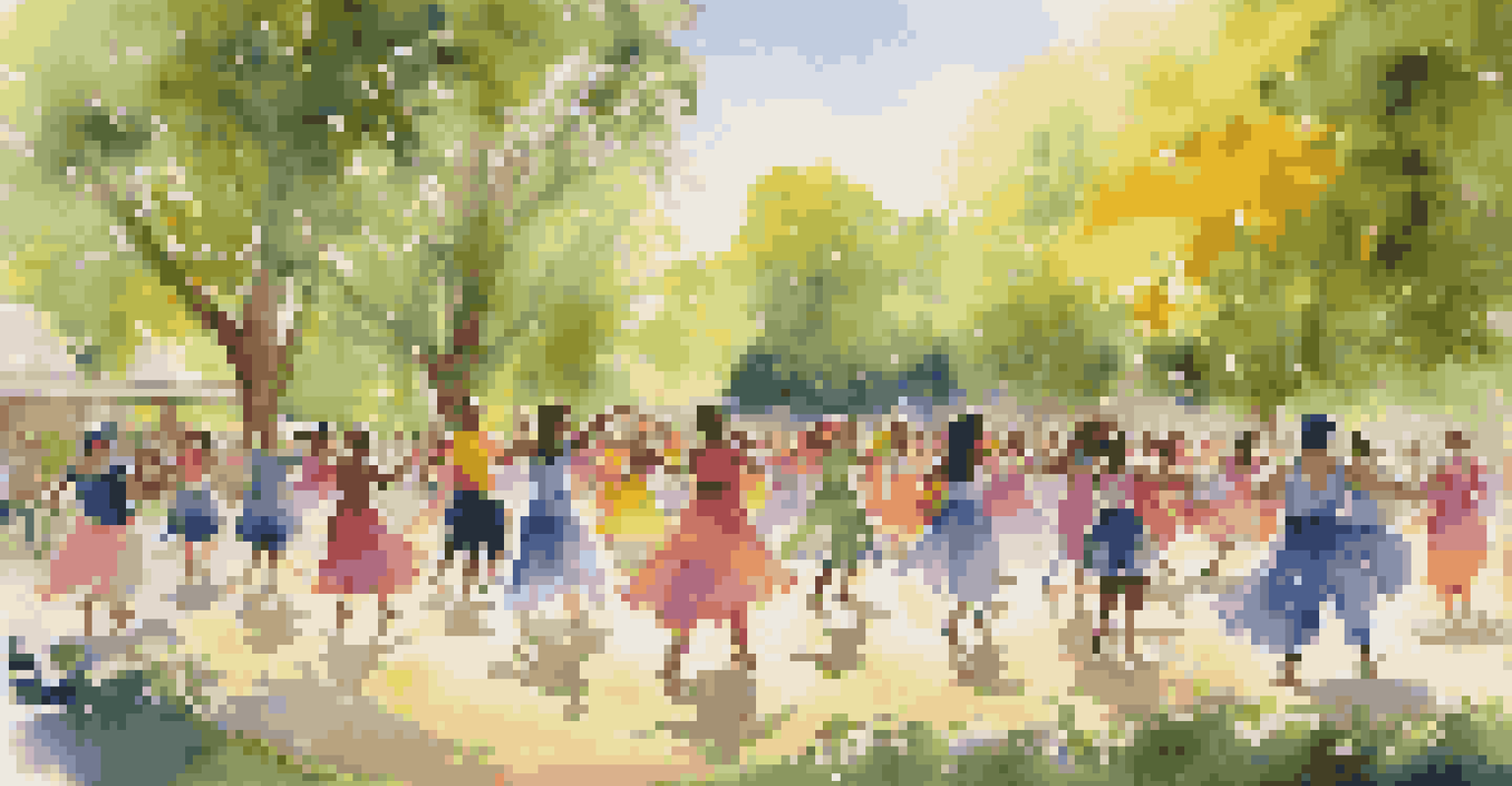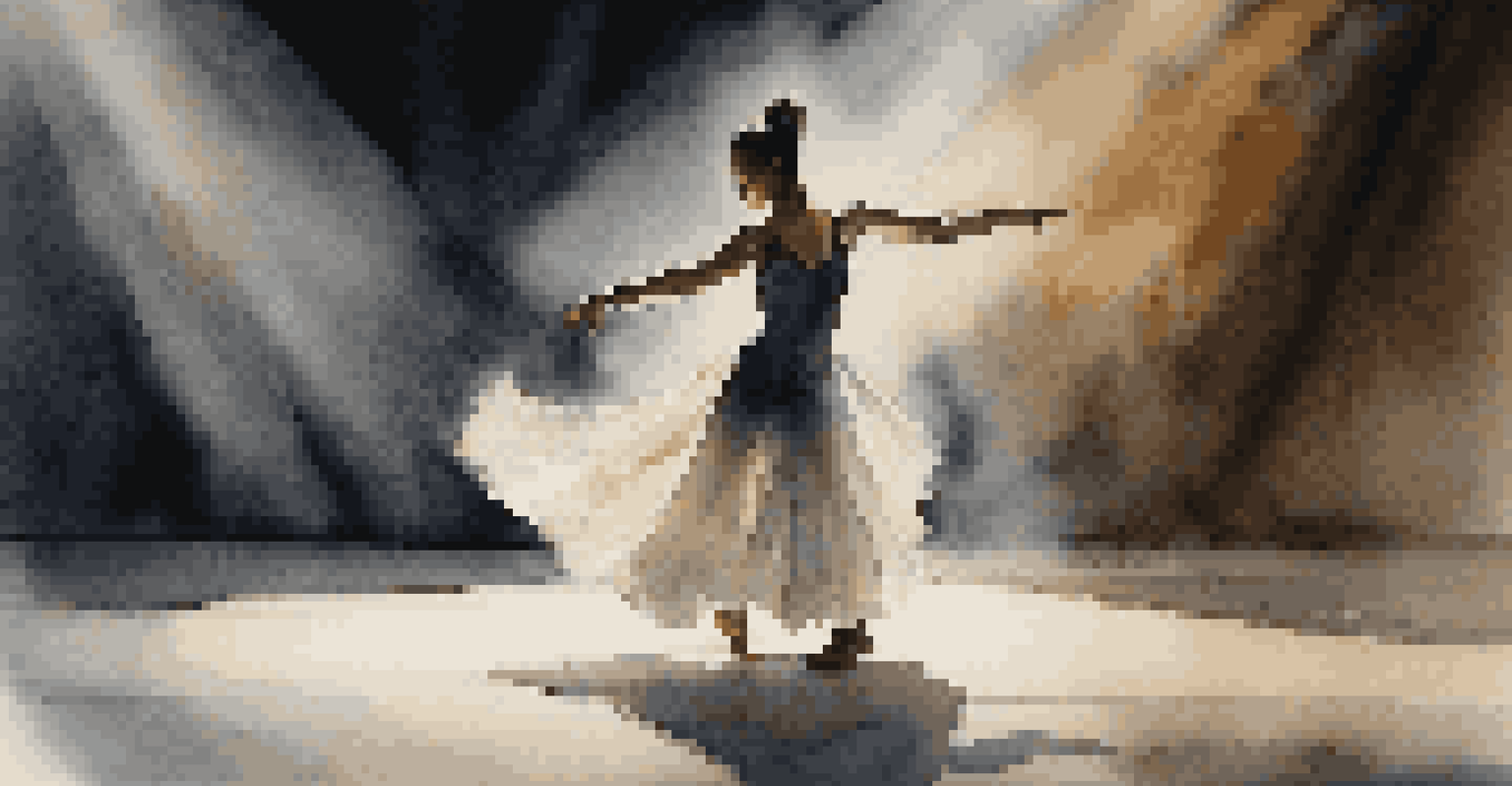The Therapeutic Benefits of Dance for Body Awareness and Health

Understanding Body Awareness Through Movement
Body awareness is the ability to recognize and understand our physical presence. Dance is a powerful tool that enhances this awareness, allowing individuals to connect with their bodies in a deeper way. When we move to music, we become more in tune with our physical sensations, which can lead to increased self-acceptance and confidence.
Dance is the hidden language of the soul.
Engaging in dance encourages us to explore different movements and postures, helping to improve our spatial awareness. This exploration not only teaches us about our bodies but also fosters a sense of freedom and creativity. As we learn to express ourselves through dance, we also cultivate a greater appreciation for our unique physicality.
Moreover, this heightened body awareness can translate into our everyday lives. When we become more conscious of how we carry ourselves, we might notice improvements in our posture, balance, and overall physical health. Ultimately, dance encourages a lifelong journey of self-discovery and body positivity.
The Connection Between Dance and Mental Health
Dance is not just a physical activity; it's also a powerful mental health booster. Engaging in dance can release endorphins, the body's natural mood lifters, leading to feelings of joy and happiness. This makes dance an effective way to combat stress, anxiety, and even depression.

In addition to the biochemical benefits, dance fosters social connections, which are crucial for mental well-being. Participating in group dance classes or community events allows individuals to bond with others, share experiences, and build a supportive network. These social interactions can significantly enhance one's mood and self-esteem.
Dance Enhances Body Awareness
Engaging in dance improves our physical awareness, promoting self-acceptance and creativity.
Furthermore, dance provides an outlet for emotional expression. Whether it’s through the rhythm of a fast-paced salsa or the fluidity of contemporary dance, individuals can express their feelings in a safe and constructive way. This release can be incredibly therapeutic, paving the way for emotional healing and resilience.
Improving Physical Health with Dance
Dance is an enjoyable way to get moving and improve physical health. It offers a full-body workout, enhancing cardiovascular fitness, strength, and flexibility. Whether you’re breaking a sweat with hip-hop or gracefully spinning in ballet, every style of dance can contribute to a healthier heart and body.
To watch us dance is to hear our hearts speak.
Moreover, dance can help maintain a healthy weight and improve body composition. As a fun alternative to traditional workouts, it encourages regular physical activity without feeling like a chore. This can be especially beneficial for those who struggle with motivation in conventional fitness routines.
Lastly, dance can enhance coordination and motor skills, which are essential for overall physical health. As we age, maintaining these skills becomes increasingly important to prevent falls and injuries. By incorporating dance into our lives, we can nurture these abilities while having fun.
Dance as a Tool for Rehabilitation
Dance has proven to be an effective rehabilitation tool for individuals recovering from injuries. Movement therapies often incorporate dance elements to help patients regain strength, flexibility, and coordination. This can make the rehabilitation process more enjoyable and less daunting.
In many rehabilitation settings, dance is used to improve mobility and enhance physical function. For instance, individuals recovering from strokes may find that dancing helps them regain control over their movements and rebuild their confidence. The rhythmic patterns of dance can also aid in retraining the brain’s motor pathways.
Dance Boosts Mental Health
Participating in dance releases endorphins and fosters social connections, both of which are crucial for mental well-being.
Additionally, the social aspect of dance can play a crucial role in recovery. Group dance classes provide a sense of community and support, which can be invaluable for those undergoing rehabilitation. This shared experience can motivate participants to stay committed to their recovery journey.
Cultivating Mindfulness Through Dance
Mindfulness is the practice of being present and fully engaged in the moment, and dance can be a beautiful way to cultivate this skill. When we dance, we often lose ourselves in the music and movement, allowing our minds to quiet and focus entirely on the experience. This meditative quality can lead to a greater sense of peace and well-being.
As we become more attuned to our bodies during dance, we also learn to listen to our emotions and thoughts. This heightened awareness can help us navigate life’s challenges with greater clarity and calmness. It’s a form of moving meditation that can have lasting benefits beyond the dance floor.
Furthermore, incorporating mindfulness into dance can enhance our overall enjoyment and satisfaction. By focusing on the sensations and emotions that arise during movement, we can deepen our connection to ourselves and the world around us. This practice of mindful dancing can transform how we experience life.
Dance as a Form of Self-Expression
Dance serves as a powerful medium for self-expression, allowing individuals to communicate feelings and experiences that words sometimes cannot capture. Through movement, we can convey joy, sadness, anger, and love, providing an outlet for emotions that may otherwise remain bottled up. This form of expression can be incredibly liberating.
Participating in dance can also help individuals discover their unique style and voice. Whether through improvisation or choreographed pieces, dancers learn to embrace their individuality. This journey of self-discovery can lead to increased self-confidence and a stronger sense of identity.
Dance Aids Physical Rehabilitation
Dance serves as an effective rehabilitation tool, helping individuals regain strength and mobility while providing social support.
Moreover, expressing oneself through dance can foster a sense of community and belonging. When we share our movements with others, we create connections that transcend language and cultural barriers. This shared experience enriches our lives and promotes empathy and understanding.
The Joy of Dance: Fostering a Positive Outlook
One of the most delightful aspects of dance is the joy it brings. Whether you’re dancing alone in your living room or participating in a lively group class, the sheer act of moving to music can elevate your mood and spark happiness. This joy can have a ripple effect, promoting a more positive outlook on life.
Engaging in dance encourages us to let go of inhibitions and embrace spontaneity. This playful approach to movement can remind us not to take life too seriously and to find joy in the little things. Dance invites us to celebrate our bodies and the gift of movement.

Additionally, the joy of dance can inspire creativity in other areas of our lives. When we allow ourselves to be playful and expressive through dance, we often find that this creativity spills over into our daily activities. By fostering a joyful relationship with movement, we can enhance our overall well-being and happiness.